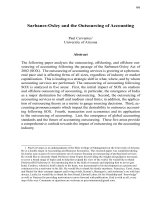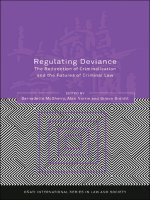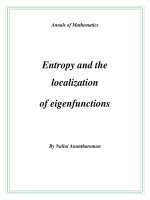Statehood and the Law of Self-Determination docx
Bạn đang xem bản rút gọn của tài liệu. Xem và tải ngay bản đầy đủ của tài liệu tại đây (27.58 MB, 516 trang )
Statehood
and the Law of
Self-Determination
Developments
in
International
Law
VOLUME
43
Statehood
and the Law of
Self-Determination
David Raic
Kluwer
Law
International
The
Hague
/
London
/
New
York
A
C.I.P. Catalogue record
for
this book
is
available
from
the
Library
of
Congress.
ISBN
90-411-1890-X(HB)
Published
by
Kluwer
Law
International,
P.O.
Box
85889,
2508
CN The
Hague,
The
Netherlands.
Sold
and
distributed
in
North, Central
and
South America
by
Kluwer
Law
International,
101
Philip Drive, Norwell,
MA
02061,
U.S.A.
In all
other countries, sold
and
distributed
by
Kluwer
Law
International,
Distribution
Centre,
P.O.
Box
322, 3300
AH
Dordrecht,
The
Netherlands.
Printed
on
add-free
paper
All
Rights Reserved
©
2002 Kluwer
Law
International
Kluwer
Law
International incorporates
the
publishing programme
of
Martinus
Nijhoff
Publishers.
No
part
of
this work
may be
reproduced, stored
in a
retrieval system,
or
transmitted
in any
form
or by any
means, electronic, mechanical, photocopying, microfilming,
recording
or
otherwise, without written permission
from
the
Publisher, with
the
exception
of any
material supplied specifically
for the
purpose
of
being
entered
and
executed
on a
computer system,
for
exclusive
use by the
purchaser
of the
work.
Printed
in the
Netherlands
Table
of
Contents
Table
of
Abbreviations
xiii
Acknowledgements
xix
INTRODUCTION
1
PART
I:
STATEHOOD
CHAPTER
1 THE
CONCEPTS
OF
'SUBJECT
OF
LAW'
AND
'PERSONALITY'
IN
INTERNATIONAL
LAW
§ 1.
Introduction
9
§ 2. The
meaning
of
'subject
of
international law'
and
'international personality'
10
§ 3.
Conclusion
18
CHAPTER
2 THE
STATE
AS AN
INTERNATIONAL LEGAL PERSON
§ 1.
Introduction
19
§ 2. The
notion
of the
State
20
§
2.1.
The
State
as a
political
and
social organization
§
2.2.
The
State
as a
legal concept under international law:
legal personality, attributes
and
legal criteria
for
statehood
21
§
2.3. Sovereignty
25
§ 3.
Recognition
of
States
and the
acquisition
of
international
personality
28
§3.1.
The
constitutive theory
29
§
3.2.
The
declaratory theory
32
§ 4. The
theories
on
recognition revisited
33
§
4.1. Evaluation
of the
constitutive theory
33
vi
Table
of
Contents
§
4.2. Evaluation
of the
declaratory theory
38
§ 5.
Collective, implied, constitutive
and
obligatory recognition
of
statehood
and
admission
to
membership
in the
United
Nations
39
§ 6.
Conclusions
48
CHAPTER
3 THE
TRADITIONAL CRITERIA
FOR
STATEHOOD
AND
THE
CONCEPT
OF
EFFECTIVENESS
§ 1.
Introduction
49
§ 2.
Statehood
and the
notion
of
effectiveness
in
international
law 50
§
2.1. Raison d'être
and
function
of
effectiveness
50
§
2.1.1. Absence
of a
central organ with general
powers
of
attribution
and
enforcement
of
rights
and
obligations
50
§
2.1.2.
Legal order
52
§
2.1.3. Legal security
53
§
2.2.
Legal
effects
of
effectiveness
53
§
2.3.
The
meaning
of
effectiveness
in the
context
of the
formation
of
States
57
§ 3. The
traditional criteria
for
statehood
58
§3.1. Permanent population
58
§
3.2. Defined territory
59
§
3.3. Government
62
§
3.4.
The
capacity
to
enter into relations with other States
73
§
3.5. Independence
74
§
3.5.1. Formal independence
76
§
3.5.2. Actual independence
78
§ 4.
Recognition
and the
traditional criteria
for
statehood
82
§ 5.
Retroactivity
of
recognition
of
statehood
83
§6. The
moment
of the
commencement
of
statehood
85
§ 7.
Conclusions
86
CHAPTER
4 THE
OBLIGATION
OF
NON-RECOGNITION
AND
ADDITIONAL CRITERIA
FOR
STATEHOOD BASED
ON
LEGALITY
§ 1.
Introduction
89
§ 2. The
prohibition
of
premature recognition
92
§
2.1.
No
recognition without 'permissive' recognition?
93
Table
of
Contents
vii
5
2.2. Non-fulfilment
of the
traditional criteria
for
statehood
and
recognition
95
§
2.2.1.
Colonialism
and
state formation through national
liberation wars:
the
requirement
of
effective
government
and the
operation
of
the
right
of
self-determination
95
(a)
Algeria
96
(b)
Guinea Bissau
98
(c)
Angola
99
(d)
The
Congo
100
§
2.2.2.
The
formation
of
States
and
ineffective
government
in the
post-colonial
era 101
§
2.3. Observations
101
§ 3. The
meaning
of the
doctrine
of
obligatory non-recognition
105
§ 4. The
origin
and
development
of the
doctrine
of
obligatory
non-recognition
in
practice
113
§ 5.
State
practice
in the
field
of
non-recognition
of
claims
to
statehood
116
§
5.1.
The era of the
League
of
Nations
116
§
5.2.
The era of the
United Nations
122
§
5.2.1. Violation
of the
prohibition
of the use of
force,
in
particular
the
prohibition
of
aggression
122
§
5.2.2. Violation
of the
right
of
peoples
to
self-determination
128
(a)
The
case
of
Southern Rhodesia
128
(b)
The
South African Homeland territories
134
§
5.2.3. Violation
of the
prohibition
of
systematic
racial
discrimination including
the
prohibition
of
Apartheid
140
§ 6. The
character
of the
legal norms involved
141
§7. The
legal
basis
of the
obligation
of
non-recognition
150
§ 8.
Modern criteria
for
statehood based
on
legality
151
§ 9.
Limits
to the
obligation
of
non-recognition
158
§ 10.
Non-recognition
and the
European Community Declaration
on
the
Guidelines
on the
Recognition
of New
States
in
Eastern Europe
and in the
Soviet Union
165
§11. Conclusions
and
observations
167
viii
Table
of
Contents
PART
II:
SELF-DETERMINATION
CHAPTER
5 THE
EMERGENCE
AND
DEVELOPMENT
OF THE
PRINCIPLE
OF
SELF-DETERMINATION:
FROM
THE
AMERICAN
AND
FRENCH REVOLUTIONS
TO THE
ERA
OF
DECOLONIZATION
§ 1.
Introduction
171
§ 2.
Political
and
philosophical foundations
172
§
2.1.
The
American
and
French Revolutions: democratic
political
theory
172
§
2.2. Nationalism
176
§ 3.
From
a
political principle
to a
legal right
177
§
3.1.
Woodrow
Wilson
and
'Wilsonian
self-determination'
177
§
3.2.
Vladimir
Ilyich
Lenin
and
self-determination
184
§
3.3. Self-determination
in the
aftermath
of
World
War I 188
§
3.3.1.
Versailles
188
§
3.3.2.
The
League
of
Nations
193
§
3.3.3.
National
self-determination
as a
gift
196
§
3.4.
The
United Nations
and
decolonization
199
§
3.4.1.
The
liberation
of
colonial peoples
and
territories:
towards
a
right
of
self-
determination
199
§
3.4.2.
The
subject
of the
right
of
self-determination
and the
principle
of
territorial integrity
206
§
3.4.3.
Implementation
and
legal
status
of
self-determination
210
§
3.4.4. Decolonization
and
statehood
219
§ 4.
Reflections
and
conclusions:
raison
d'être
and
core
meaning
of
political self-determination
220
CHAPTER
6 THE
POST-COLONIAL ERA: INTERNAL
AND
EXTERNAL
SELF-DETERMINATION
§ 1.
Introduction
226
§ 2.
Self-determination beyond decolonization
227
§
2.1.
The
continuing character
of
self-determination
and
its
internal
dimension
228
§
2.2.
The
meaning
of
internal self-determination
and its
surplus
value
237
§ 3. The
subject
of
internal self-determination
242
Table
of
Contents
ix
§
3.1.
The
territorial definition:
the
entire population
of
existing States
244
§
3.2.
The
'ethnic'
definition: subgroups within existing
States
247
§
3.3. Minorities
265
§ 4.
Internal self-determination
as a
right
under international
law 272
§ 5. The
right
of
external self-determination: meaning
and
exercise
289
§ 6. The
principles
of
territorial integrity
and uti
possidetis
293
§ 7.
Conclusions
and
observations
305
CHAPTER
7
SECESSION
§ 1.
Introduction
308
§ 2.
Theoretical
approaches
to a
right
of
secession
309
§ 3.
Acknowledgment
of a
right
of
secession
313
§
3.1. Recognition
of a
right
of
secession under national
law
or
approval
by the
central government
313
§
3.2. International instruments, doctrine
and
judicial
decisions
316
§
3.2.1. International instruments
316
§
3.2.2.
Doctrine
324
§
3.2.3. Judicial decisions
and
opinions
328
§
3.2.4. Observations
332
§
3.3.
Successful
secessions
and
international practice
332
§
3.3.1.
Bangladesh
335
§
3.3.2. Croatia
342
(a)
History
342
(b)
Secession
and/or
dissolution
of the
SFRY?
356
(c)
Entitlement
to
unilateral secession?
361
§
3.3.3.
Acknowledgement
of the
existence
of a
qualified
right
of
unilateral secession under
international
law 362
§ 4.
Cumulative criteria
for a
right
of
unilateral secession
366
§
4.1. Minority-people
366
§
4.2. Territorial bond
367
§
4.3.
A
direct
or
indirect violation
of the
right
of
internal
self-determination
367
x
Table
of
Contents
§
4.4. Exhaustion
of all
effective
judicial remedies
and
realistic
political arrangements
for the
purpose
of
realizing
the
right
of
internal self-determination
370
§
4.4.1.
The
catalytic agent: widespread
and
serious
violations
of
individual human rights
372
§ 5.
Unsuccessful unilateral secessions:
the
cases
of the
Chechen
Republic
of
Ichkeria,
the
Republic
of
Abkhazia
and the
Republic
of
Serbian Krajina
372
§
5.1.
The
Chechen Republic
of
Ichkeria
373
§
5.2.
The
Republic
of
Abkhazia
379
§
5.3.
The
Republic
of
Serbian Krajina
386
§ 6.
Conclusion:
the
norms
of
territorial
integrity
and
secession
revisited
394
PART
III:
STATEHOOD
AND
SELF-DETERMINATION
CHAPTER
8 THE
FORMATION
OF
STATES
AND THE
OPERATION
OF
THE LAW OF
SELF-DETERMINATION
§ 1.
Introduction
401
§ 2.
Recognition
of
statehood despite
the
existence
of an
ineffective
government: modern state practice
and the
role
of
the
right
of
self-determination
402
§
2.1.
The
cases
of
Georgia
and
Moldova
402
§
2.1.1.
The
Republic
of
Georgia
402
§
2.1.2.
The
Republic
of
Moldova
405
§
2.2. Observations
406
§
2.3. External self-determination
and the
statehood
criterion
of
'government':
juridical
and
empirical
statehood
408
§
2.4.
The
special case
of the
Republic
of
Bosnia-
Herzegovina
414
§ 3. The law of
self-determination
and the
criteria
for
statehood:
the
unlawful
proclamation
of
independence
418
§
3.1.
The
prohibition
of
abuse
of the
right
of
self-
determination:
the
requirement
of
fulfilment
of the
conditions
of the
qualified right
of
secession
419
§
3.2. Respect
for the
right
of
internal self-determination
of
peoples
423
Table
of
Contents
xi
§ 4. The
proper subject
of the
right
of
unilateral secession
as a
criterion
for
statehood
425
§ 5. The
formation
of
States, self-determination
and
recognition
426
§ 6.
Conclusions
437
PRECIS
§ 1. The
formation
of
States, traditional criteria
for
statehood
and
recognition
439
§ 2. The
obligation
of
non-recognition
of
statehood:
the
introduction
of the
notion
of
legality
in the law
of
statehood
and
additional criteria
for
statehood
441
§ 3. The law of
self-determination
443
§ 4.
Statehood
and
self-determination
449
§ 5. The
modern
law of
statehood
451
Bibliography
453
Table
and
Index
of
Cases
481
Index
485
This page intentionally left blank
Table
of
Abbreviations
Add.
African
JICL
Am. U.
Int'l
L.
Rev.
Ann.
AJIL
AFDI
APSR
AP
App(s).
Art(s).
ASIL
Aust.
YIL
Blaustein
and
Flanz
(Eds.),
CONSTITUTIONS
Buchheit,
SECESSION
B.
Univ.
ILJ
Brownlie,
PRINCIPLES
BYIL
Case
W.
Res.
JIL
Cassese, SELF-
DETERMINATION
cert.
Chen,
RECOGNITION
CERD
Addendum
African
Journal
of
International
and
Comparative
Law
American University International
Law
Review
Annex(es)
American Journal
of
International
Law
Annuaire Français
de
Droit
International
American Political Science Review
The
Associated Press
Appendi(x, ces)
Article(s)
The
American Society
of
International
Law
Australian
Yearbook
of
International
Law
A.P. Blaustein
and
G.H.
Flanz
(Eds.),
CONSTITUTIONS
OF THE
COUNTRIES
OF
THE
WORLD, multiple vols.
L.C. Buchheit,
SECESSION,
THE
LEGITIMACY
OF
SELF-DETERMINATION,
1978
Boston University International
Law
Journal
I.
Brownlie,
PRINCIPLES
OF
PUBLIC
INTERNATIONAL
LAW,
1998
British
Yearbook
of
International
Law
Case Western Reserve Journal
of
International
Law
A.
Cassese,
SELF-DETERMINATION
OF
PEOPLES,
A
LEGAL
REAPPRAISAL,
1995
certiorari
T.C.
Chen,
THE
INTERNATIONAL
LAW OF
RECOGNITION,
(L.C.
Green,
Ed.), 1951
Committee
on the
Elimination
of
Racial
Discrimination
xiv
Table
of
Abbreviations
cf.
ch
(s).
cmt.
Colum.
J.
Transnat'l
L.
Colum.
L. Rev
Comm.
Cornell
ILJ
Crawford,
CREATION
OF
STATES
CoE
CSCE
Daito Bunka Univ. Bull.
De
Visscher,
EFFECTIVITÉS
Doc.
Dugard,
RECOGNITION
Duke
JCIL
EC
EC
Guidelines
ECHR
ECHR
Ybk.
ECOSOC
Ed(s).
ed.
e.g.
Emory Int'l
L.
Rev.
ff.EC
Rep.
EJIL
EPIL
et
al.
et
seq.
compare
chapter(s)
comment
Columbia Journal
of
Transnational
Law
Columbia
Law
Review
Committee
Cornell International
Law
Journal
J.
Crawford,
THE
CREATION
OF
STATES
IN
INTERNATIONAL LAW,
1979
Council
of
Europe
Conference
on
Security
and
Co-operation
in
Europe
Daito Bunka University Bulletin
C. De
Visscher,
LES
EFFECTIVITÉS
DU
DROIT INTERNATIONAL PUBLIC,
1967
Document
J.
Dugard,
RECOGNITION
AND THE
UNITED
NATIONS,
1987
Duke
Journal
of
Comparative
and
International
Law
European Communities
Guidelines
on the
Recognition
of New
States
in on
Recognition Eastern Europe
and
the
Soviet Union, adopted
by the
member States
of the
European Community
on 16
December 1991
European Convention
on
Human
Rights
Yearbook
of the
European
Convention
on
Human Rights
Economic
and
Social Council
Editor(s)
edition
example given
Emory International
Law
Review
and
following
European Court Reports
European Journal
of
International
Law
Encyclopedia
of
Public International
Law
and
others
and
following
Table
of
Abbreviations
xv
F.
Finnish
YIL
FLN
Fordham
L.
Rev.
Friendly Relations
Declaration
FRY
Ga. J.
Int'l
&
Comp.
L.
GAOR
Gowlland-Debbas,
THE
QUESTION
OF
SOUTHERN
RHODESIA
Hague
Y.B.
Int'l
L.
Harv.
ILJ
HDZ
HR
HRC
HRQ
ICCPR
ICESCR
ICJ
ICJ
Rep.
ICLQ
id.
i.e.
IHT
Indian
JIL
ILC
Federal Reporter
Finnish Yearbook
of
International
Law
Front
Liberation Nationale
Fordham
Law
Review
Declaration
on
Principles
of
International
Law
Concerning Friendly Relations
and Co-
Operation Among States
in
Accordance With
the
Charter
of the
United Nations (General
Assembly
Resolution
2625
(XXV), 1970)
Federal Republic
of
Yugoslavia (Serbia
and
Montenegro)
Georgia
Journal
of
International
and
Comparative
Law
General Assembly
Official
Records
V.
Gowlland-Debbas,
COLLECTIVE
RESPONSES
TO
ILLEGAL
ACTS
IN
INTERNATIONAL LAW:
UNITED
NATIONS ACTION
IN THE
QUESTION
OF
SOUTHERN RHODESIA,
1990
Hague
Yearbook
of
International
Law
Harvard International
Law
Journal
Croatian Democratic Union
Hague
Recueil (Recueil
des
Cours
de
1'Académic
de
Droit
International
de La
Haye)
Human
Rights Committee
Human Rights Quarterly
International Covenant
on
Civil
and
Political
Rights
International Covenant
on
Economic, Social
and
Cultural Rights
International Court
of
Justice
Reports
of
Judgments, Advisory Opinions
and
Orders
of the
International Court
of
Justice
International
and
Comparative
Law
Quarterly
the
same
that
is
International Herald
Tribune
Indian Journal
of
International
Law
International
Law
Commission
xvi
Table
of
Abbreviations
ILC
Ybk.
ILM
ILR
Int. Aff.
Israel
L.
Rev.
IYHR
JIA
JNA
JO
Lauterpacht,
RECOGNITION
Law &
Contemp.
Probs.
LQR
LJIL
LN
LNOJ
LNTS
Marek, IDENTITY
Mich.
JIL
Mod.
L.
Rev.
Montevideo
Convention
mtg.
NATO
New
Engl.
L.
Rev.
NILR
n(n).
Nord.
JIL
Notre
Dame
L.
Rev.
No(s).
NQHR
NYIL
NYT
OAS
OAU
ONUC
Yearbook
of the
International
Law
Commission
International Legal Materials
International
Law
Reports
International
Affairs
Israel
Law
Review
Israeli
Yearbook
of
Human
Rights
Journal
of
International
Affairs
Yugoslav
National Army
Journal
Officiel
H.
Lauterpacht,
RECOGNITION
IN
INTERNATIONAL
LAW, 1947.
Law and
Contemporary
Problems
Law
Quarterly Review
Leiden
Journal
of
International
Law
League
of
Nations
League
of
Nations
Official
Journal
League
of
Nations Treaty Series
K.
Marek,
IDENTITY
AND
CONTINUITY
OF
STATES
IN
PUBLIC INTERNATIONAL
LAW,
1954
Michigan Journal
of
International
Law
Modern
Law
Review
Montevideo Convention
on
Rights
and
Duties
of
States
of
1933
meeting
North
Atlantic
Treaty
Organization
New
England
Law
Review
Netherlands International
Law
Review
footnote(s)
Nordic Journal
of
International
Law
Notre
Dame
Law
Review
Number(s)
Netherlands
Quarterly
of
Human
Rights
Netherlands Yearbook
of
International
Law
New
York
Times
Organization
of
American States
Organization
of
African
Unity
Opération
des
Nations Unies
au
Congo
Table
of
Abbreviations xvii
OPPENHEIM'S
INT'L
LAW
OSCE
PAIGC
Para(s).
PASIL
PCIJ
PCIJ
Ser.
PRST
Res
(s).
Rev.
RDISDP
RGDIP
RIA
s(s).
SCOR
sess.
SFRY
Shaw,
INTERNATIONAL
LAW
SRBH
Stanford
JIL
STL
Rev.
Supp.
Syr.
JIL &
Com.
Temple
ICLJ
Trans.
TRNC
UDI
UHLR
OPPENHEIM'S
INTERNATIONAL LAW,
Vol.
I,
Peace,
(R.
Jennings
and A.
Watts
Eds.), 1992
Organization
on
Security
and
Co-operation
in
Europe
African
Independence Party
of
Guinea
and
the
Cape Verde Islands
Paragraph(s)
Proceedings
of the
American Society
of
International
Law
Permanent Court
of
International Justice
Publications
of the
Permanent Court
of
International Justice, Series
A, B and C
Statement
by the
President
of the
Security
Council
Resolution(s)
Revised
Revue
de
Droit International,
de
Sciences
Diplomatiques
et
Politiques (The International
Law
Review)
Revue
Général
de
Droit International Public
Review
of
International
Affairs
section(s)
Security Council
Official
Records
session
Socialist
Federal Republic
of
Yugoslavia
M.N.
Shaw,
INTERNATIONAL LAW,
1997
The
Socialist Republic
of
Bosnia-Herzegovina
Stanford
Journal
of
International
Law
Suffolk
Transnational
Law
Review
Supplement
Syracuse
Journal
of
International
Law and
Commerce
Temple
International
and
Comparative
Law
Journal
Translated
Turkish Republic
of
Northern Cyprus
Unilateral declaration
of
independence
University
of
Hawaii
Law
Review
xviii
Table
of
Abbreviations
UN
UNESCO
UNCIO
UNDP
UNFICYP
UNTS
UNRIAA
US
USLW
v.
Va.
JIL
Vand.
J.
Transnat'l
L
Vol(s).
WEU
Wis.
ILJ
Yale
LJ
ZaöRV
United
Nations
United Nations Educational,
Scientific
and
Cultural Organization
United Nations Conference
on
International
Organisation
United Nations Development Programme
United Nations Force
in
Cyprus
United Nations Treaty Series
United
Nations
Reports
of
International
Arbitral
Awards
United States
Law
Reports (Supreme Court)
United States
Law
Week
against
Virginia
Journal
of
International
Law
Vanderbilt
Journal
of
Transnational
Law
Volume(s)
West
European Union
Wisconsin International
Law
Journal
Yale
Law
Journal
Zeitschrift
für
ausländisches
öffentliches
Recht
und
Völkerrecht
Acknowledgements
This
book
was
written
as a
thesis
for the
Doctorate
of
Laws, Leiden University.
I am
most grateful,
first of
all,
to my
supervisor, Professor Peter Kooijmans.
Throughout
my
working
at
this study
he
allowed
me to
make
use of his
wisdom while
at the
same time
affording
inspiration
and
freedom.
He
never
permitted
his
demanding task
as a
Judge
at the
International Court
of
Justice
to
stand
in the way of
discussing
my
thesis with
me for
many hours.
I
also wish
to
express
my
profound gratitude
to
Professor John
Dugard,
who
acted
as
referent.
I
benefited
very
much from
his
wise suggestions
and
advice.
The
process
of
writing
a
thesis cannot
be
gone
through
without
the
support
of
many people. This book
is no
exception
to
that rule.
I
thank
my
mother,
Amy
Raic-van
Es, and my
sister, Romana Raic,
both
of
whom,
despite
so
many
difficulties,
have always kept
faith
in me as
well
as in the
fact
that this work
would
be
completed.
I
thank
my
late father Mise Raic,
who
motivated
me to
interpret
the
facts
of
life
as
objectively
as
possible.
I
thank Stella Zerbo
for her
love,
warmth, patience
and
impatience.
I
thank Marianne Jonker
for
supporting
me and
this project
for so
many years.
I am
fully
aware that this
was not an
easy
task. Special thanks
are
owed
to
René Lefeber, without whom this work
would never have seen
the
light
of the day in its
present
form
and
with whom
I
have discussed almost every issue
in it. I
also,
and in
particular, wish
to
thank
Mrs.
A.
Broekers-Knol,
Head
of the
Moot
Court
Department
of
Leiden
University,
who
believed
in my
scientific
skills
and
realized
the
funds
for the
research.
I
thank Niels Blokker
for his
advice
and
inspiration.
I
thank Guido
Biessen
who
always tried
to
(and eventually did) convince
me
that
I
could
cut
a
few
pages
or
sections
(if
possible
a
chapter)
and who
always kept
on
motivating
me to finish the
work.
The
Hague,
May
2002
DR
This page intentionally left blank
Introduction
Standing
on the
moon, watching
the
earth
from
a
different
perspective,
one
sees
water
and
land, and,
if one
would take
a
closer look,
one
might
see
mountains, rivers,
forests
and
deserts.
If one
would
get
even closer
to the
surface
of
the
earth,
one
would
be
able
to
distinguish cities, lakes
and
roads.
One
would, however, search
in
vain
if one
would wish
to
identify
a
'State'.
The
reason
is
obvious:
the
State
is
primarily
a
legal concept, that
is to
say,
it is a
fictitious
concept, created
by man for
certain purposes.
From
the
perspective
of
international
law it is
therefore relevant
to
know
exactly
what kind
of
entities
qualify
as a
State and,
in
particular, when they
do so.
As
has
been observed
by one
scholar:
[g]enerally, international lawyers proceeded from
the
assumption that since
the
end of the
decolonization process
the
surface
of the
globe
was
covered
by a
given
number
of
entities which almost
all
bore
the
characteristics
of a
sovereign State.
In
this respect,
with
the
exception
of
small corrections
here
and
there,
history
seemed
to
have come
to its
irreversible end.
The
distribution
of the
land surface
of the
earth
not
only
between
any
States,
but
between
the
currently existing
States
was
considered more
or
less
final.
The
dissolution
of the
Soviet Union
and
Czechoslovakia
as
well
as the
violent
disintegration
of the
Socialist Federal Republic
of
Yugoslavia have disproved
this assumption, however.
The
communities
of the new
entities which have
sprung
up
from
the
aforementioned States have achieved that
for
which they
were striving, eventually, namely
the
establishment
of a
State.
A
growing
number
of
communities within existing States
are
attempting,
by
pacific
or by
violent
means,
to
attain
the
same goal.
To
legitimize their claim they
refer
to
the
right
of
self-determination
of
peoples
- and
especially
to a
'right
of
unilateral secession' which
is
claimed
to be
encompassed
by the
aforementioned
right.
In
this context,
one may
refer
to the
declarations
of
independence
of, or
the
aspirations
to
secession
of,
amongst others, Transdniestr
and the
Republic
of
Gagauzia
(of
Moldova), Abkhazia
(of
Georgia),
Kosovo
(of the
Federal
1.
C.
Tomuschat,
Self-Determination
in a
Post-Colonial World,
in: C.
Tomuschat
(Ed.),
MODERN
LAW
OF
SELF-DETERMINATION,
1993,
p. 1, at p. 5.
2
Introduction
Republic
of
Yugoslavia),
the
Turkish Republic
of
Northern Cyprus
(of
Cyprus),
Chechnya
(of the
Russian Federation),
the
Republic
of
Serbian
Krajina
(of
Croatia),
the
Serb Republic
of
Bosnia-Herzegovina
(of
Bosnia-Herzegovina)
and
Somaliland
(of
Somalia). Although several
of
these entities existed,
or
still
do
exist,
as
completely
effective
territorial entities, none
of
them have been
recognized
as a
State
by the
international community.
The
striving
of
communities
for
statehood
is, of
course,
an old
phenome-
non.
For
instance, against
the
background
of
nationalism,
the
Versailles peace
settlement
led to the
(re-)birth
of
numerous States
in
Europe.
To
that
effect,
Butler observes,
the
Versailles Treaties have been described
as the
"balkan-
isation
of
Europe".
2
But
there were others, apart
from
the
nationalities
who
were
allowed
to
establish their
own
State,
who
favoured
the
peace settlement
and
considered
it
right
and
inevitable.
3
Whether
or not one
agrees with this
conclusion,
the
same forces
of
national feeling have certainly
not
ceased
to
operate,
nor
have they become weaker
in the
course
of the
twentieth
and
twenty-first
century. Indeed,
to
speak with Cobban, "[w]e
may
approve them,
or we may
condemn them,
but we
cannot ignore them".
4
For an
international
lawyer
at
least,
the
challenge
is
thus
to
find
out
whether international
law
contains rules
and
principles regulating these
forces
and
their outcomes.
The
problem
of the
right
of
self-determination, particularly
in the
post-
colonial era,
is
formed
in
essence
by the
fact
that this
right can
have
a
tense
relationship
with
the
principle
of
state sovereignty.
The
right
of a
State
to
having
its
territorial integrity respected,
is a
corollary
of
State sovereignty.
On
the
basis
of
this principle, States possess
the
right
to
uphold their borders
if
these
are
threatened either
from
the
outside
or
from
the
inside.
On the
other
hand,
the
right
of
self-determination was,
in the
aftermath
of
World
War I
and
during
the
period
of
decolonization
at
least, primarily seen
as a
concept
which could
justify
the
separation
of a
part
of the
territory
of an
existing State
for
the
purpose
of
establishing
a new
State.
Thus,
the
right
of
self-determina-
tion
is at
least potentially aimed
at
territorial change. Consequently,
the
aspiration
of
communities within existing States
to the
creation
of
their
own
State
on the
basis
of an
alleged right
of
self-determination,
and the
attempts
of the
parent
States
to
preserve
their
territorial status quo,
is the
source
of the
majority
of
conflicts with which
the
international community
finds
itself
confronted almost daily.
It is
sometimes argued that these claims
to
self-determination
as
well
as
the
situations which arise
as a
result
of an
alleged exercise
of
that right, must
2.
H.
Butler,
THE
LOST PEACE, 1941,
p.
124.
3. Id.
4.
A.
Cobban,
THE
NATION STATE
AND
NATIONAL
SELF-DETERMINATION,
1969,
p. 21.
Introduction
3
simply
be
ignored, that these matters
are not
regulated
by
international
law
or
that they
are
unsuitable
for
legal regulation.
In
addition,
it has
been
suggested that
the
recognition
of the new
States which
were
formed within
the
boundaries
of the
former Yugoslavia
and the
former Soviet Union must mainly
be
explained
in
terms
of
politics.
5
In
other words,
the
creation
and
recognition
of
these
new
States should
be
seen
to
have taken place mainly outside
the
domain
of
international law.
These
situations
and
these contentions thus raise
the
following
question:
does
international
law
contain
any
rules
and
principles
on the
basis
of
which
the
formation
and
recognition
of
some entities,
and the
ignoring
and
non-recognition
of
others,
can be
explained?
In the
light
of the
aforementioned developments,
the
main question
of
this
study
is:
when does
an
entity
qualify
as a
State under international law,
and
what,
if
any,
is the
role
of the law of
self-determination
in the
process
of the
formation
of
States
in
international
law?
This
question raises
a
number
of
sub-questions: does international
law
contain objective, that
is,
legal, criteria
for
statehood
on the
basis
of
which
it
is
possible
to
determine
whether
or not an
entity qualifies
as a
State?
What
is
the
role
of
(non-)recognition
in the
creation
of
States?
Is the
formation
of
a
State solely
a
'matter
of
fact'
or is it
(also)
a
'matter
of
law'?
That
is to
say,
does
the law of
statehood contain rules barring
the
acquisition
of
statehood
of a
territorial entity
if the
said entity
has
been established
in
violation
of
international
law?
What
is the
role
of the
right
of
self-determination
in
this
regard?
If
self-determination
may
justify
and
legitimize
the
formation
of
a
State,
in
what instances does such
a
justification
and
legitimation exist?
And
what
is
the
legal status
of an
entity
if it has
been established without such
a
legal
basis?
This
last question
is
intimately related
to
another one: does
a
right
of
unilateral
secession exist
in the
post-colonial
era?
If so,
when does
it
exist
and
who is the
holder
of
such
a
right?
How
does this right relate
to the
principle
of
territorial integrity,
and how
does
it
relate
to the
principle
of
uti
possidetis?
Finally,
if a
right
to
unilateral secession
does
exist
under
certain circumstances
(that
is,
under certain conditions), what
is the
legal status
of an
entity which
is
created whilst
the
conditions
for the
existence
of a
right
to
unilateral secession
were
not
(yet)
satisfied?
To
this end, this study
is
divided into three parts.
Part
I,
entitled
'State-
hood',
consists
of
four
chapters.
This
part will
focus
primarily
on the
concept
of
'State'
in
international law,
first
from
the
perspective
of the
more
or
less
generally accepted
law of
statehood,
and
thereafter
in the
light
of
additional
5.
See, e.g.,
R.G.C,
Thomas,
Self-Determination
and
International Recognition Policy:
An
Alternative
Interpretation
of Why
Yugoslavia Disintegrated,
World
Affairs,
Vol. 160, 1997,
p. 17.
4
Introduction
criteria
for
statehood which
may be
suggested
on the
basis
of
modern state
practice.
In
that respect, some basic legal concepts, such
as
'subject
of
international law'
and
'personality', will
be
examined
in
Chapter
1.
Chapter
2
addresses
the
general characteristics
and
attributes
of
statehood,
as
well
as
the
role
of
recognition
in the
process
of the
formation
of
States. Chapter
3
analyses
the
content
and
status
of the
so-called 'traditional' criteria
for
statehood, which
are
factual
criteria based
on the
pre-condition
of
effectiveness.
Some
suggested
additional criteria
for
statehood which
are
based
on
legality
rather than
effectiveness
are
discussed
in
Chapter
4,
against
the
background
of the
doctrine
of
non-recognition
of
illegal acts
and
situations.
It
will
be
seen
that
a
number
of
question relating
to
statehood
and the
status
of
certain
entities
remain unanswered
on the
basis
of the
discussion
as it has
developed thus far.
It is
submitted that these questions
may be
answered
from
the
perspective
of
the law of
self-determination.
Part
II of the
study, entitled 'Self-Determination', consists
of
three chapters
focusing
on the
rules
and
principles
of the law of
self-determination. Chapter
5
charts
the
development
of the
concept
of
self-determination
from
its
first
international appearance during
World
War I up to and
until
its
role
in the
context
of
decolonization.
This
analysis
leads
to a
formulation
of the
raison
d'être
and
main objective
of the
principle
of
self-determination
insofar
as
this
may
be
deduced
from
the
development
of the
concept
in the
said period.
In
Chapter
6, the
analysis
of the law of
self-determination
is
taken
a
step further.
In
this
Chapter,
the
question
of
whether
or not the
right
of
self-determination
extends beyond decolonization
and if so, in
what
form
is
examined.
In
this
respect both
the
'internal'
and the
'external' aspect
of the
right
of
self-
determination will
be
addressed. Also,
the
legal status
of
(internal
and
external)
self-determination
in the
post-colonial
era is
analysed,
as
well
as the
(potential)
holder
of
that right.
It
will
be
shown that
the
right
of
self-determination does
extend beyond
the
colonial context
as a
continuing right, primarily
in the
form
of
'internal'
self-determination. However,
in
certain aspects external
self-
determination
is
also
a
continuing right,
in the
sense that
the
entire population
of a
State
is
always
free
to
choose integration
in, or
association with, another
existing State.
The
exercise
of the
external aspect
of
self-determination leads
to a
change
in the
external boundaries
of a
State.
It has
been suggested that
the
right
of
self-determination, particularly
in its
'external' form,
conflicts
outright with
two
other principles
of
international law:
the
principle
of
territorial integrity
and the
principle
of
uti
possidetis.
The
content
of
these
two
principles
as
well
as
their relation
to the
right
of
self-determination
is
addressed
in
the
final
part
of
Chapter
6. The
question
of the
existence
of a
right
of
unilateral
secession
is
dealt with
in
Chapter
7 on the
basis
of a
number
of
case









